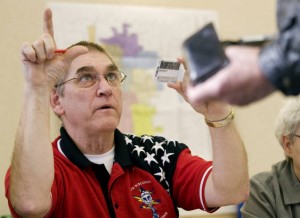Few problems reported with Wisconsin’s new voter ID requirements
The first elections under Wisconsin’s new photo identification law went off relatively smoothly, with the few problems mostly due to voters showing up at the wrong polling sites because of recent redistricting, local elections officials said Wednesday.
Voter ID has been a divisive issue nationwide, with supporters saying it helps prevent voter fraud and opponents arguing that it disenfranchises some voters. Republicans who control the state Legislature passed a law last year requiring voters to show photo identification at the polls, and the law went into effect with Tuesday’s primary elections.
No statewide candidates were on the ballot but about 525 municipalities and several counties held primaries for city council and county supervisors.
Local elections officials said voters generally showed up with their IDs in hand. A bigger problem was getting voters to the proper polling sites after local redistricting moves shifted ward boundaries.
The city of Sheboygan had perhaps the hottest race in the state, holding its first mayoral recall election. Former state Rep. Terry Van Akkeren ousted Mayor Bob Ryan. The election stemmed largely out of Ryan’s problems with alcohol, including fallout from a three-day drinking binge last July. Witnesses say Ryan passed out at a bar and was involved in a scuffle.
City clerk Susan Richards said nearly 40 percent of the city’s 30,000 registered voters cast a ballot. She hadn’t heard of any serious problems with voter I D.
D.
“For a change, things were relatively easy,” Richards said. “We had a few people grumbling because they just didn’t like the idea (of presenting photo ID to vote) or whatever, but very few.”
La Crosse County held three supervisor primaries. County clerk Ginny Dankmeyer said her poll workers didn’t run into any problems with voter ID – county officials had encouraged voters to bring their IDs to the polls last year in a dry run – but they had to point some voters to the right polling places after new district boundaries left them confused.
“People were calling to ask where to go to vote,” Dankmeyer said. “People out in the towns and villages used to going to the same place weren’t in the supervisory district on the ballot.”
The story was the same in Green Bay, which held city council primaries in five districts. Interim city clerk Kris Teske said she didn’t hear of any voter ID problems, although poll workers had to redirect voters confused over new ward boundaries to the correct polling location.
“I know it wasn’t very many,” Teske said. “It was really nice. I was happy.”
Fifteen states have a voter ID law, and legislation pending in 26 states would introduce voter ID laws or strengthen existing ones.
Republicans generally maintain that voter ID laws prevent fraud at the polls. Opponents say the requirement is really an attempt to disenfranchise Democratic-leaning constituencies who may lack IDs, such as the elderly and minorities. The League of Women Voters, the NAACP and the ACLU all have filed lawsuits challenging Wisconsin’s law.
Meanwhile, the state Government Accountability Board, which oversees Wisconsin elections, has launched a major ad campaign to educate voters on what they need when they go to the polls. The push includes a new website, print ads, billboards, and television and radio spots.
Richards, the Sheboygan city clerk, said the push has helped.
“It paid off,” she said. “I think the public is so well-educated on this now.”
The elections didn’t go off without a hitch everywhere.
Sun Prairie held one city council primary and a judicial primary. City clerk Diane Hermann-Brown said most people showed up with their IDs, but two men began shouting at poll workers, saying they didn’t need to produce any. One swore and the other accused the workers of being part of a conspiracy, Hermann-Brown said.
She talked to both of them, and they eventually produced their IDs and voted.
“I don’t understand as an individual what good it did to yell at myself or take their aggression out on my poll workers. We don’t make the law,” Hermann-Brown said.
Things didn’t go all that well for Gilbert Paar, either. The 69-year-old voter from Mount Pleasant tried using his U.S. Department of Veterans Affairs card, which he uses to collect veterans benefits. The card includes Paar’s photo but isn’t considered an acceptable form of identification under the new law.
When poll workers asked him if he had a driver’s license, he told them he did but refused to show it and walked out without voting, he said.
“I went to vote with the military ID that gave me the right to vote by serving four years in the Air Force,” he said.
Related Posts
« Howard sand mine deal hailed as model for others! Masses of plastic particles found in Great Lakes »

